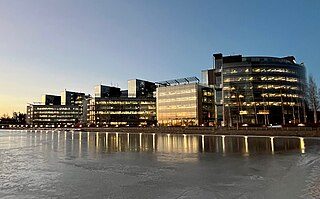
The electricity sector in Norway relies predominantly on hydroelectricity. A significant share of the total electrical production is consumed by national industry.

Fortum Oyj is a Finnish state-owned energy company located in Espoo, Finland. It mainly focuses on the Nordic region. Fortum operates power plants, including co-generation plants, and generates and sells electricity and heat. The company also sells waste services such as recycling, reutilisation, final disposal solutions and soil remediation and environmental constructions services, and other energy-related services and products e.g. consultancy services for power plants and electric vehicle charging. Fortum is listed on the Nasdaq Helsinki stock exchange.

The Åråsen Stadion, officially written Åråsen stadion, is an all-seater football stadium located in Lillestrøm, a city east of Oslo in Skedsmo, Norway. With a capacity of 11,500 spectators, the venue is the home of the Eliteserien side Lillestrøm SK (LSK). The stadium has four stands, of which the West Stand has luxury boxes and club seating for 700. Because of the stadium's proximity to Kjeller Airport, it has retractable floodlights. The record attendance of 13,652 dates from 2002. In addition to league, cup and UEFA Cup matches for LSK, the venue has been used for one Strømmen IF top-league match in 1986, the UEFA Women's Euro 1997, eight other Norway women's national football team matches, the 2002 UEFA European Under-19 Football Championship, and seven Norway national under-21 football team matches.

Iberdrola, S.A. is a Spanish multinational electric utility company based in Bilbao, Spain. It has around 40,000 employees and serves around 30 million customers.

Statkraft AS is a hydropower company, fully owned by the Norwegian state. The Statkraft Group is Europe's largest generator of renewable energy, as well as Norway’s largest and the Nordic region's third largest energy producer. Statkraft develops and generates hydropower, wind power, gas power, district heating and solar power. It is also a player in the international energy markets. The company has 5,300 employees in 21 countries with their headquarters located in Oslo, Norway.
Skagerak Energi is a Norwegian utility company. The company's main focus is production and distribution of electrical power and other energy, in addition to business areas related to this. The group has about 600 employees, and an annual power production of 5 TWh, about 176,000 grid customers, and an annual revenue of NOK 2 billion.
Amedia AS is the second largest media company in Norway. The company is whole or partial owner of 50 local and regional newspaper with online newspapers and printing presses, and its own news agency, Avisenes Nyhetsbyrå.

Eidsiva Energi is a Norwegian energy company based in Hamar with large sections of Oppland and Hedmark as core market, and is the largest producer, distributor and trader of electricity in both counties. The corporation had a revenue of NOK 3.5 billion and market capitalization of NOK 9 billion in 2006. It is owned by Hedmark County as well as by 25 municipalities.
The electricity sector in Peru has experienced large improvements in the past 15 years. Access to electricity has increased from 45% in 1990 to 96.4% in 2018, while service quality and efficiency of service provision improved. These improvements were made possible through privatizations following reforms initiated in 1992. At the same time, electricity tariffs have remained in line with the average for Latin America.
Østfold Energi is a Norwegian energy producer within the business areas of hydropower, wind and heat. The company operates hydroelectric power plants in Østfold and Sogn og Fjordane with an annual power production of 1,680 TW·h/year. The power plants operated by Østfold Energi are Borgund power plant, Stuvane power plant, Nyset-Steggje power plant, Brekke power plant, Tistedalsfoss power plant and Ørje power plant.

El Salvador's energy sector is largerly focused on renewables. El Salvador is the largest producer of geothermal energy in Central America. Except for hydroelectric generation, which is almost totally owned and operated by the public company CEL, the rest of the generation capacity is in private hands. With demand expected to grow at a rate of 5% in the coming years, the Government's 2007 National Energy Strategy identified several hydroelectric and geothermal projects as the best option to meet demand in the future and to diversify the country's energy mix.

The renewable-energy industry is the part of the energy industry focusing on new and appropriate renewable energy technologies. Investors worldwide are increasingly paying greater attention to this emerging industry. In many cases, this has translated into rapid renewable energy commercialization and considerable industry expansion. The wind power, solar power and hydroelectric power industries provide good examples of this.

Norway is a heavy producer of renewable energy because of hydropower. Over 99% of the electricity production in mainland Norway is from 31 GW hydropower plants. The average hydropower is 133 TWh/year. There is also a large potential in wind power, offshore wind power and wave power, as well as production of bio-energy from wood. Norway has limited resources in solar energy, but is one of the world's largest producers of solar grade silicon and silicon solar cells.
Ivar Ueland was a Norwegian politician from the Conservative Party.
Brookfield Renewable Partners L.P. is a publicly traded limited partnership that owns and operates renewable power assets, with corporate headquarters in Toronto, Ontario, Canada. It is 60% owned by Brookfield Asset Management.

Denmark's western electrical grid is part of the Synchronous grid of Continental Europe whereas the eastern part is connected to the Synchronous grid of Northern Europe via Sweden.
Bugoye Power Station is a 13 MW (17,000 hp) mini hydroelectric power station in Uganda. In the literature, Bugoye Power Station is sometimes referred to as Mubuku II Power Station.
Energy in Serbia is dominated by fossil fuels, despite the public preference for renewable energy.

Augustin Thoresen Paus was a Norwegian engineer and industrial leader who played a key role in hydropower development in Norway through the first half of the 20th century. He graduated as an officer from the Military Academy and as a civil engineer from Dresden, starting his engineering career at Norsk Hydro as an associate of Sam Eyde during the development of the Rjukan industrial facilities. From 1918, he led the construction of the hydroelectric Rånåsfoss power plant, one of the largest in Europe. Upon its completion in 1922, he became the first managing director of Akershus elektrisitetsverk, a position he held until his death. He was described as the "absolute ruler" of the industrial community that emerged at Rånåsfoss. He also held several other positions in the Norwegian power industry and was described as "one of the most prominent leaders in the Norwegian energy industry." He served as chairman of Glommens og Laagens Brukseierforening, Foreningen Samkjøringen—the precursor to the Nordic electricity exchange Nord Pool—the Norwegian Museum of Cultural History, and several power companies.










